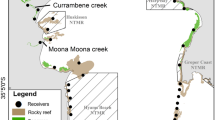Abstract
I examine how dispersal of juvenile creek chubs (Semotilusatromaculatus) from beaver ponds into adjacent stream environments interacts with temporal abiotic variability to influence fish foraging, growth, and long-term persistence in the lotic ecosystem. Minnow trapping in upstream and downstream beaver ponds, along with weir traps used to monitor directional movement, indicated that most chubs colonized the stream from the downstream beaver pond. Large annual fluctuations in density of age 0 creek chubs occurred in the stream over a 10-year sampling period. Multiple regression analysis indicated that stream temperature, precipitation, and the density of reproductive creek chubs were not correlated with summer density of age 0 chubs in the stream. The factor most strongly associated with increased density of age 0 creek chubs was creation of the downstream beaver pond during the 6th–7th years of the study, suggesting dispersal from the pond was the primary factor determining age 0 fish density in the stream. Most individuals in the strong year classes neither persisted in the stream through their first winter nor resulted in an increased abundance of older age classes in later years. Comparison of age 0 fish density in summer to the proportion of fish surviving to age 1 in spring suggested that overwinter mortality was density dependent. Furthermore, a comparison of the size structure for age 0 individuals in summer to age 1 individuals the following spring indicated that winter mortality was size dependent. Experiments in an artificial stream adjacent to the natural channel revealed that fish growth was strongly density dependent, decreasing as fish density increased across both spring and summer, and elevated and low discharge. The decline in invertebrate prey captured by the fish and the subsequent decline in fish growth appeared to be particularly pronounced under low discharge in summer. Changes in juvenile creek chub density had no significant effect on benthic insect or crustacean abundance, suggesting that exploitative competition for limited invertebrate drift resources was a more important cause of density- dependent growth than depressed local benthic invertebrate abundance. These results suggest that lotic regions adjacent to beaver ponds act as potential reproductive “sinks” for dispersing juveniles confronting seasonal and flow-mediated restrictions on resource acquisition and growth, and the occurrence of seasonal bottlenecks to their survival, especially harsh winter conditions.
Similar content being viewed by others
Author information
Authors and Affiliations
Additional information
Received: 9 September 1996 / Accepted: 8 August 1997
Rights and permissions
About this article
Cite this article
Schlosser, I. Fish recruitment, dispersal, and trophic interactions in a heterogeneous lotic environment. Oecologia 113, 260–268 (1998). https://doi.org/10.1007/s004420050377
Issue Date:
DOI: https://doi.org/10.1007/s004420050377




